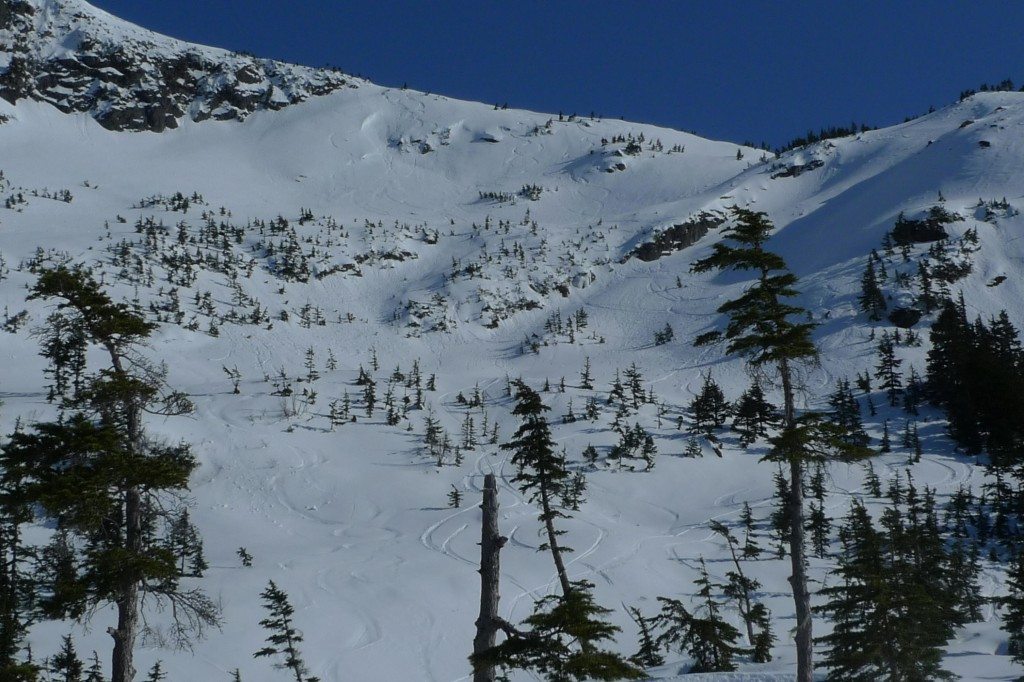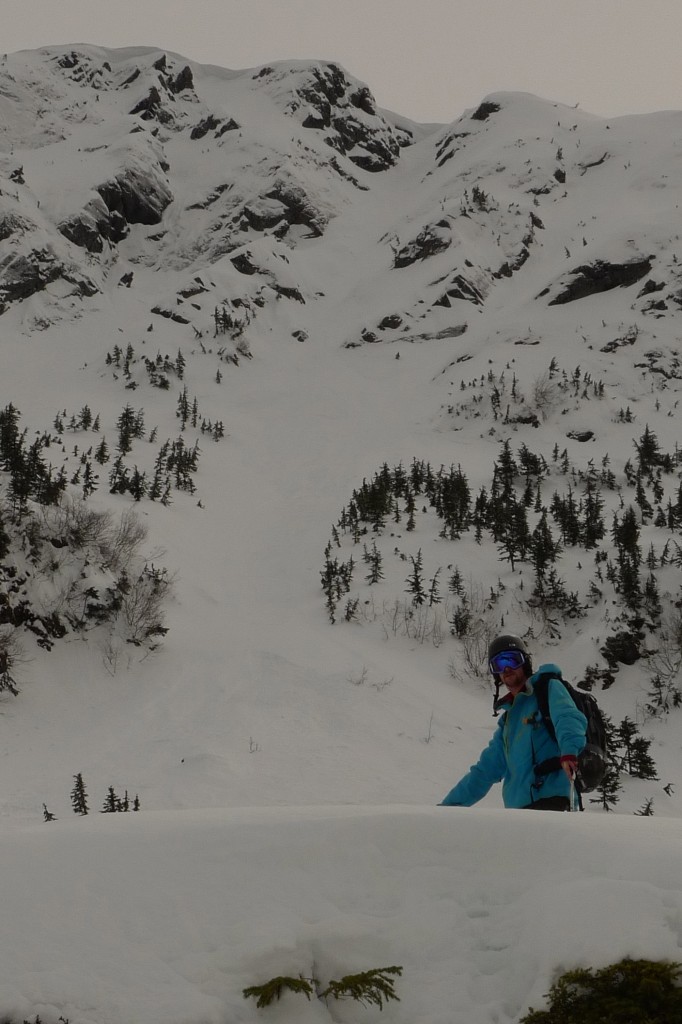Ski: 2010-2011 ON3P Caylor, 191cm 
Dimensions (mm): 148-120-140
Turn Radius: 27.4 meters
Actual tip to tail length – straight tape pull: 193cm
Boots / Bindings: Nordica Supercharger Ignition / Head Mojo 15, DIN at 12
Mount Location: recommended (3cm back from true center)
Test Location: Arapahoe Basin; Eaglecrest; Colorado and Alaska Backcountry
Days Skied: ~25
The past few seasons I’ve been on an epic quest to find the perfect powder ski, or at least my perfect powder ski. During my search I spent time on a handful of fun-shape skis: the Armada JJ, Armada ARG, K2 Hellbent, Moment Bibby Pro, Moment Donner Party, and Praxis Mountain Jib, just to name a few. While all of these skis were particularly good at certain things, none had the versatility that I sought. I was after a ski that excelled in all soft-snow conditions, backcountry trickery, and that could survive when the snow was less than ideal. After a few years of searching – and ever evolving ski design – I finally found my ski.
The Caylor is a soft snow machine, and dominates in a variety of conditions. This winter, I was able to ride the Caylor in nearly every variety of soft snow imaginable: perfect, blower pow; old, faceted sugar; thick, wind-affected snow; heavy maritime pow; rain-soaked slop; and deep slush. In the most difficult of conditions I never struggled with the Caylor. A medium-stiff flex was neither too soft nor too stiff; it simply felt good in all forms of powder. I could feel the skis flex and respond to my movements. Although a soft flex on an aggressively rockered ski can be quite fun (e.g., the K2 Hellbent), a stiffer flex like that of the Caylor provides a greater amount of versatility. This stiffer flex certainly didn’t diminish my desire to go airborne, and in some cases, I preferred it.
One of the biggest selling points for me was that the Caylor is designed for backcountry trickery as well as full-throttle charging. Lots of rocker, a very balanced swing weight, and a medium-stiff flex made backcountry jumps, spinning off cliffs, and natural airs a breeze.
I love to ski fast and fluid, taking sizable airs while rarely stopping at the tops of cliffs. I felt very confident landing big airs on the Caylor and had no problem sending it into the unknown. Pulling out of landings was easy in the deepest and heaviest of powder. Landing switch in deep snow was also no problem for the Caylor, and the supportive flex forgave both backseat and “frontseat” switch landings. I have never before been on a ski that stomps so well in powder. Stiff, slightly rockered, or traditionally cambered powder skis tend to dive in deep landings, while soft rockered skis tend to collapse upon impact. The Caylor provided a very happy medium between these two extremes.
The Caylor felt rather heavy in my hands, but it didn’t swing heavy on my feet. I would call the Caylor’s swing weight average. But even with a 191cm length, I never felt as though I had too much ski when spinning or going inverted. (I also did short tours with the Caylors and Alpine Trekkers throughout the season. Even this ridiculous touring setup didn’t feel deal-breakingly heavy, but like I said, these were short tours.)

While the Caylor certainly has a jibby feel, it is not as “butterable” (c’mon, that’s a word, right?) as a softer, rockered powder ski. In powder, the aggressively rockered profile allows the Caylor to be buttered around fairly easily, but on firmer snow, the skis moderately stiff flex was difficult for my 165 pound self to press. The 191cm length didn’t help much with butters either….
(The good news: those looking to do this kind of jibbing need not worry – for 2011/2012, ON3P will be making a “Caylor Lite” in 181cm and 191cm. The Caylor Lite is targeted toward lighter skiers and will have a softer, more playful flex. But the Caylor Lites will only be available in limited quantities, so check them out soon if they sound interesting to you. Ok, now back to our review.)
At Eaglecrest (in Juneau, AK), which is where I did most of my skiing on the Caylor, some of the best snow can be found in the tightest of trees. Naturally, I spend a lot of time in these trees sniffing out the last stashes after a storm. The Caylor let me quickly and easily maneuver through these tight spaces and negotiate the hairiest of pillow lines with confidence. As long as the snow was somewhat soft, I could turn on a dime.
In open areas this maneuverability made the Caylor quite playful. Turns of all shapes and sizes – and at all speeds – were effortless. I often found myself making a variety of turns on a wide open face: start with some Super G style turns to get my speed up, throw a slash to scrub some speed, and then cruise down to the bottom with shorter, more playful turns.
All powder days give way to deeply trenched chop, and a versatile powder ski must be able to handle these unavoidable conditions. The Caylor does, and with few issues. Generous rocker, that moderately-stiff flex, and a large shovel enabled the Caylor to blast through deep chop. I did experience a little bit of tip deflection in this type of snow, but only when I lost focus when skiing at high speeds. As long as I stayed forward and worked to drive the Caylors, I was fine.
My confidence in the Caylor’s performance in choppy conditions inspired me to rip a BN down a thousand foot chute in the Eaglecrest slackcountry without a second thought. (+10,000 GNAR points!!! And obviously, I straight-lined for additional points – !!!) Unfortunately I had failed to anticipate the slide debris that had accumulated at the bottom of the line. At such high speed, this hardened, wet slide debris really bucked me, but I only feared for the safety of my…naked flesh…for a few moments, till the Caylor’s supportive tail helped me to stabilize and prevent some serious snow burn.

The Caylor can also lay trenches in lightly chopped snow and on groomers. An aggressively rockered profile can be intimidating on groomers, but I’ve found if I look up and maintain a forward or centered stance, I’ll hardly notice the smaller contact length on firm snow. A stiff flex helps to cut down on always unsettling tip flapping. This flex, combined with camber underfoot, gives the Caylor a snappy feel on groomed and well compacted snow.
I didn’t feel like I was sacrificing too much performance on firmer snow despite the Caylor’s significant rocker. It was the only ski that I had with me in Juneau this winter, and even with a few week-long snowless periods, I didn’t feel like I needed a different ski to tackle the firm conditions. For in-bounds skiing at Arapahoe Basin and around Summit County, however, I felt the Caylor was more ski than I needed. With the light continental snow, one could easily get away with a skinnier, less rockered ski. And yet, if it is used primarily as a backcountry or dedicated powder ski, the Caylor would still be an excellent choice in continental areas.
The only conditions that the Caylor didn’t handle well were ice, rock-hard chop, and icy moguls. This is hardly surprising, considering the ski’s intended use. The shorter running length didn’t allow me to get enough edge on ice. In hard chop, as with the Black Diamond Amperage, I felt stuck in turns and I had a hard time rolling the ski from edge to edge. This fact, combined with a wide profile, made icy mogul skiing tricky.
But you shouldn’t be breaking out the Caylors in these conditions anyway. If you run into snow like this en route to the next pow stash, it won’t be especially enjoyable, but you’ll certainly survive.
After 25 days of abuse, my Caylors are still in excellent shape. I have hit numerous rocks that I thought for sure would leave serious gouges in the bases. Many of these collisions have resulted in only small scratches, if they’ve left any mark at all. I haven’t had much of an issue with topsheet chipping, especially for a ski with sandwich construction. Scratches will show on the glossy topsheet, but this is purely cosmetic. I did have one minor delam in the tip after a week or so of use, which was easily fixed with some epoxy.
ON3P has produced a bomber powder ski for people looking to do it all in soft snow. ON3P is based out of Portland, Oregon, and the Caylor’s design reflects this. As part of a quiver (which for me consists of the Caylor, a park ski, and a mountaineering / lengthy touring ski), the Caylor will see a lot of use in places like Tahoe, Hood, Baker, Whistler, etc. As I mention above, I think the Caylor wouldn’t see as much use for those skiing inbounds farther from the coast, but it is certainly a great deep-day ski for any quiver.

For 2011/ 2012, the Caylor is undergoing some tweaks. New for next year is what ON3P is calling “elliptical rocker.” Basically, this will be a smoother rocker profile with less camber underfoot (it will be pretty much flat underfoot). The folks here at BLISTER will be getting our hands on this new model, and I’ll be out testing it as soon as the snow starts to fly.
Can’t wait.
